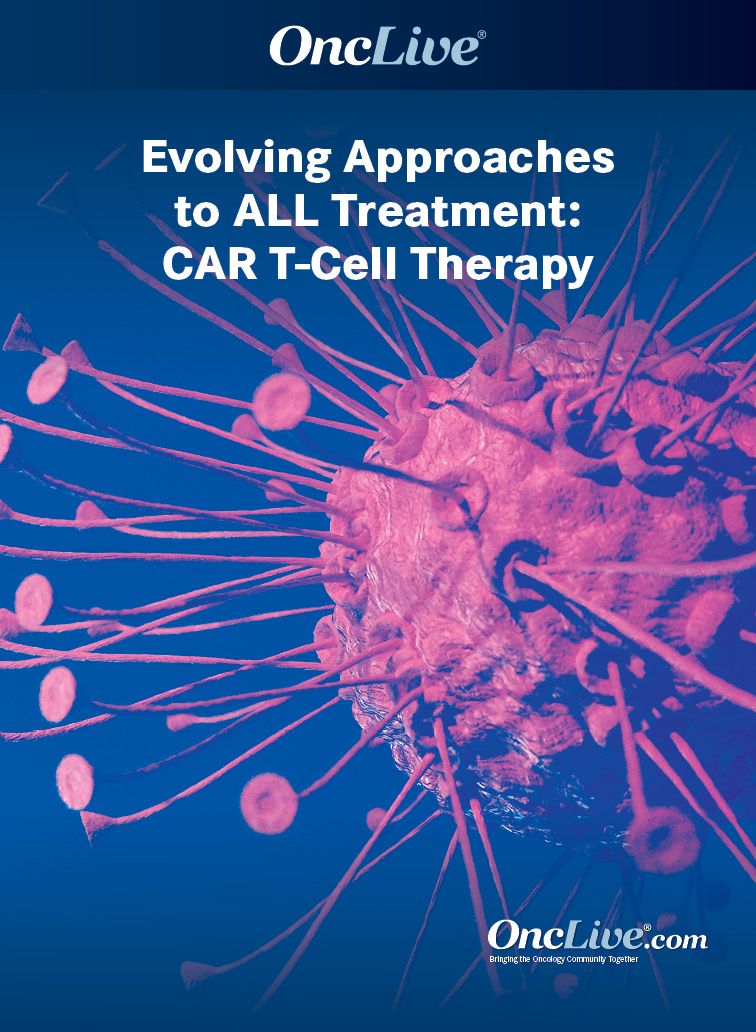News
Article
Obe-Cel Elicits High Remission Rates in R/R B-ALL Irrespective of Leukemic Burden
Author(s):
Obecabtagene autoleucel elicited durable responses in patients with relapsed or refractory B-cell acute lymphoblastic leukemia independent of leukemic burden at lymphodepletion, although better outcomes were observed in those with lower burden.
Claire Roddie, MD

Obecabtagene autoleucel (obe-cel) elicited durable responses in patients with relapsed or refractory B-cell acute lymphoblastic leukemia (B-ALL) independent of leukemic burden at lymphodepletion, although better outcomes were observed in those with lower burden, according to data from a pooled analysis of the FELIX study (NCT04404660) presented at the 2023 ASH Annual Meeting.1
In the phase 1b/2 study, at a median follow-up of 11.0 months, the rate of complete response (CR)/CR with incomplete hematologic recovery (CRi) was 77% (95/124), and in patients with minimal residual disease (MRD) at screening, 9 out of 10 evaluable patients had CR/CRi, with 100% having MRD negative status by flow cytometry.
“The durable remission rates and toxicity inversely correlated with leukemia burden at lymphodepletion and the assessment of leukemic burden at lymphodepletion appears to be essential for risk-benefit stratification,” said Claire Roddie, MD, associate professor of hematology at University College London in the United Kingdom, in her presentation.
The FELIX study enrolled patients with relapsed/refractory B-ALL in 3 cohorts to receive obe-cel, an autologous chimeric antigen receptor (CAR) T-cell therapy with a novel CD19 binding domain designed to improve safety and persistence over approved CAR T-cell products. Cohort A enrolled patients with morphological disease of at least 5% bone marrow (BM) blasts, Cohort B enrolled those in their second or later CR/CRi with measurable MRD, and Cohort C enrolled those with isolated extramedullary disease. The primary end point for Cohort A was CR/CRi rate and for Cohort B was MRD at 10-4 sensitivity, with secondary end points including duration of response (DOR), event-free survival (EFS), overall survival (OS), and safety.
Prior results from Cohort A, presented at the 2023 American Society of Clinical Oncology Annual Meeting, showed a CR/CRi rate of 70% (95% CI, 55%-82%; P < .0001) in the first 50 patients enrolled.2 In 92 patients evaluated for safety, there was a rate of cytokine release syndrome of 63%, 3% of which was grade 3 or higher, and a rate of immune effector cell–associated neurotoxicity syndrome (ICANS) of 23%, 8% of which was grade 3 or higher.
Patients may have received bridging therapy as needed and received lymphodepletion with fludarabine (4 × 30 mg/m2) and cyclophosphamide (2 × 500 mg/m2).1 The target dose of CAR T cells was 410 × 106 CAR T cells; this was split between day 1 and day 10 of treatment. Patients with 20% or less BM blasts 6 days prior to infusion received 100 × 106 cells at day 1 and 310 × 106 cells at day 10, whereas those with less than 20% BM blasts received 10 × 106 cells on day 1 and 400 × 106 cells on day 10. The day 10 dose was not given if CRS of grade 2 or higher or ICANS occurred.
A total of 127 patients received therapy; the median age of enrolled patients was 47 years old (range, 20-81) and 52% were men. They had received a median of 2 prior therapies, with 35% receiving at least 3 prior lines and 21 (17%) receiving both blinotumumab (Blincyto) and inotuzumab ozogamicin (Besponsa). Fifty-six (44%) had received prior allogeneic stem cell transplant (SCT).
“I think we get a feel for the high disease burden that these patients present with at screening,” said Roddie. “In fact, the BM blast percentage median for our patients was 36%, with some patients with 100% blasts at that time point, and we’ve also got a population that’s enriched for extramedullary disease at screening, comprising 23% of the total cohort.
Roddie reported that manufacturing of obe-cel was robust and rapid, with a median time of vein-to-release of 22 days and successful manufacture in 95%, even with leukapheresis performed on patients with high leukemic burden and prior allogeneic SCT.
In 98 patients with morphologic disease, 74% of patients had CR/CRi and 95% of those evaluated were MRD negative after treatment. In 29 without morphologic disease, 100% of evaluable patients were MRD negative. Obe-cel demonstrated high CR/CRi rates across all subgroups, including those with over 75% BM blasts and those with extramedullary disease.
At a median 16.6 months of follow-up, the estimated 6-month EFS rate was 65% (95% CI, 56%-73%) and 12-month EFS rate was 50% (95% CI, 39%-59%), with a median EFS of 11.7 months (95% CI, 7.2-not estimable). Seventeen out of 99 patients who responded went on to receive SCT during remission.
Obe-cel demonstrated a high rate of expansion and persistence, with a median Tmax of 14 days (range, 2-55) and 72% persistence in ongoing responders at the latest follow-up.
Bridging therapy was used heavily, in 118 of 127 patients (93%), which Roddie showed in relation to observed differences in BM blasts after screening but before lymphodepletion. “What this…demonstrates is that leukemia burden at screening was not necessarily predictive of leukemia burden prior to lymphodepletion, and I think it emphasizes the requirement for us to reassess disease burden prior to lymphodepletion so that we can understand the impact that our therapy is having,” she said.
Leukemic burden had an impact on EFS, with a 6-month EFS rate of 83% in those patients with less than 5% blasts, vs 72% with 5% to 75%, and 40% with greater than 75% BM blasts. The 12-month EFS rates in these respective groups were 65%, 55%, and 27%.
The rate of any-grade CRS among all patients was 69% and grade 3 or higher CRS was seen in 2%. The rate of ICANS was 25% any-grade and 7% grade 3 or higher. In patients with less than 5% BM blast the CRS rate was 47%, all grade 1 or 2. In those with 5% to 75% BM blasts, any-grade CRS occurred in 69% and grade 3 or higher in 4%, and in those with greater than 75% blasts, 88% had grade 1 or 2 CRS and 3% had grade 3 or higher. ICANS occurred in 8% of those with less than 5% BM blasts, all grade 1 or 2, whereas any-grade ICANS occurred in 18% of those with 5% to 75% blasts along with 6% grade 3 or higher, and any-grade ICANS occurred in 43% of those with greater than 75% blasts including 15% grade 3 or higher. Vasopressors were only used to treat CRS in 2.4% of patients.
The treatment-emergent adverse event (TEAE) profile was favorable overall, with only 15% admitted to an intensive care unit. Two deaths, one associated with neutropenic sepsis and one related to acute respiratory distress syndrome and ICANS, were considered treatment-related by investigators. Grade 3 or TEAEs were reported in 83%. TEAEs of grade 3 or higher included febrile neutropenia (24%), anemia (21%), neutropenia (21%), and neutrophil count decrease (20%).
“Overall, obe-cel is an effective therapy for relapsed and refractory B-ALL. There are better outcomes observed in patients with lower leukemia burden at lymphodepletion, but longer follow-up is required,” Roddie concluded.
References
- Roddie C, Sandhu KS, Tholouli E, et al. Obecabtagene autoleucel (obe-cel, AUTO1) for relapsed/refractory adult B-cell acute lymphoblastic leukemia (R/R B-ALL): pooled analysis of the ongoing FELIX phase Ib/II study. Blood. 2023;142(suppl_1):222. doi:10.1182/blood-2023-179454
- Roddie C, Sandhu KS, Tholouli E, et al. Safety and efficacy of obecabtagene autoleucel (obe-cel, AUTO1), a fast-off rate CD19 CAR, in relapsed/refractory adult B-cell acute lymphoblastic leukemia (r/r B-ALL): Top line results of the pivotal FELIX study. J Clin Oncol. 2023;41(suppl_16):7000. doi:10.1200/JCO.2023.41.16_suppl.7000










